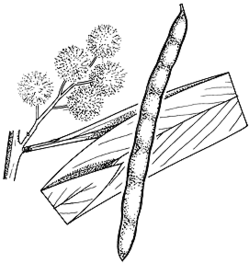Common name: golden wreath wattle, orange wattle, blue-leafed wattle, Western Australian golden wattle
Acacia saligna (Labill.) H.L.Wendl. APNI* Synonyms: Racosperma salignum (Labill.) Pedley APNI*
Acacia cyanophylla Lindl. APNI*
Mimosa saligna Labill. APNI*

Description: Erect or spreading tree or shrub 2–8 m high; bark smooth or finely fissured, brownish grey; branchlets angled or flattened, usually slightly zigzagged, often ± pruinose, glabrous.
Phyllodes thin and flexible or thick and fleshy or leathery, ± oblanceolate, straight to falcate, 7–30 cm long, 4–20 mm wide (to 50 mm wide on immature growth), green to glaucous, glabrous, midvein prominent, finely penniveined, apex subacute with a mucro; 1 gland at base.
Inflorescences mostly 2–12 on a short axillary axis or in racemes (at first enclosed by imbricate bracts 2–3 mm long); axis 0.2–5 cm long; peduncles 4–15 mm long, glabrous; heads globose, 25–55-flowered or rarely up to 75, 9–12 mm diam., bright or golden yellow.
Pods straight to strongly curved, ± flat, slightly constricted between seeds, 5–14 cm long, 4–6 mm wide, thinly leathery, glabrous, sometimes ± pruinose; seeds longitudinal; funicle short, expanded towards seed.
Flowering: July–September.
Distribution and occurrence: A Western Australian species which has become naturalised along parts of the coast and southern inland areas of New South Wales. A very adaptable and aggressive species which has become naturalised on coastal sand dunes where it was planted for dune rehabilitation, along major highways were it was included in revegetation plantings, and as a garden escape into open forests, particularly where disturbance has occurred. Former records for SWP, NFWP and SFWP are possibly cultivated.
NSW subdivisions: *NC, *CC, *SC, *NWS, ?SWS
Other Australian states: *Qld *Vic. W.A. *S.A.
The name refers to the willow-like (genus Salix) habit, with drooping branches, that often occurs in this species. May be confused with Acacia pycnantha and several other penniveined wattles. Widely cultivated and previously used for stabilising sand dunes following sand mining. It grows rapidly, selfsows and suckers freely; may spread into adjacent bushland and has become a weed in many localities. Golden Wreath Wattle should not be used for landscaping or planting in areas near bushland in the eastern states.
Text by P.G. Kodela (last edited February 2009)
Taxon concept: P.G. Kodela & G.J. Harden, Flora of NSW Vol. 2 (2002)
APNI* Provides a link to the Australian Plant Name Index (hosted by the Australian National Botanic Gardens) for comprehensive bibliographic data
***The AVH map option provides a detailed interactive Australia wide distribution map drawn from collections held by all major Australian herbaria participating in the Australian Virtual Herbarium project.
|


